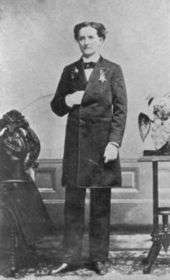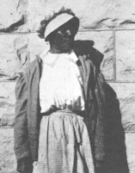Timeline of women in warfare in the United States before 1900
Timeline of women in warfare in the 19th century in America
1800s
- 19th century: Ojibwa Chief Earth Woman accompanies men on the warpath after claiming to have gained powers from a dream.[1]
- 19th century: Gouyen, an Apache woman, assassinates a Comanche chief who killed her husband in battle. She later fought beside other Apaches in a battle against a party of miners.
- 19th century: Pawnee woman Old Lady Grieves The Enemy changes the course of a battle with the Ponca and Sioux by attacking the enemy, thus shaming the men into fighting when they were in retreat.[2]
1810s–1830s
- 1811: Female nurses first included among personnel at U.S. Navy hospitals.
- War of 1812: Mary Marshall and Mary Allen nursed aboard U.S. Commodore Stephen Decatur's ship United States.[4]
- 1819: Manono II, fought along with her husband Keaoua Kekuaokalani, in the Battle of Kuamoo, where both perished in defense of the kapu system.
1830s
- 1830s: Pine Leaf of the Crow tribe is recorded as having counted coup.
- 1836: The Warner Sisters come to Constitution Island. For a half century, Susan and Anna Warner wrote popular novels and taught Sunday School to West Point cadets. Susan wrote a Wide Wide World, one of the nation's best sellers, in the 1850s. Anna wrote the words to the children's verse “Jesus Loves Me.” They later donated the island to the United States Military Academy in 1908. The remains of both sisters lie in the West Point cemetery.[5]
- Women were first officially assigned as keepers in the Lighthouse Service of the U.S. Coast Guard beginning in the 1830s although many wives and daughters of keepers had previously served as keepers when their husbands or fathers became ill. Women continued as lighthouse keepers until 1947.[6]
1840s
- 1842: Kuilix, a female warrior of the Pend d'Oreilles leads a group of warriors to rescue another group from the Blackfeet. Women of both the Pend d'Oreilles and the related Flathead tribe actively participated in warfare, entering battles and dancing in war dances.
- Mexican War (1846–1848): Elizabeth Newcom enlists in Company D of the Missouri Volunteer Infantry as Bill Newcom. She marches 600 miles from Missouri to winter camp at Pueblo, Colorado, before she is discovered to be a woman and discharged. In 1846 Sarah Borginnes is hailed as the "Heroine of Fort Brown" following her actions during the Siege of Fort Texas. She goes on to operate a series of inns providing food, lodging, liquor, and prostitutes to Zachary Taylor's troops.[4]
- 1846: Kuilix participates in a fight against the Crow.
1850s
- 1850s: Hanging Cloud becomes the first and only woman of the Ojibwa tribe to become a full warrior.
- 1851: Eliza Allen publishes her memoirs about her experiences of disguising herself as a man and fighting in the Mexican–American War.[7]
- 1858: Battle of Spokane Plain. Colestah of the Yakama tribe participates.[8]
- 1859: From 1859 to 1862 Maria Andreu (a.k.a. Maria Mestre de los Dolores) served as the Keeper of the St. Augustine Lighthouse in Florida, becoming the first Hispanic-American woman to serve in the U.S. Coast Guard and the first Hispanic-American woman to oversee a federal shore installation.[6]
1860s
- Civil War (1861–1865): Women provide casualty care and nursing to Union and Confederate troops at field hospitals and on the Union Hospital Ship Red Rover. Biologically female soldiers on both sides wear male clothing in order to serve; some of them, such as Albert Cashier, were transgender men. By the end of the war, over 500 fully paid positions were available to women as nurses and in the United States Military.[4]
- 1861: Dr. Mary Walker was a doctor with the Union Army at the First Battle of Bull Run (Manassas) and three later major engagements, but was later captured and spent the remainder of the war as a prisoner of war. She held the rank of captain. She was the first American female prisoner of war; she was captured on April 10, 1864; she was released on August 12, 1864, in exchange for a Confederate major. At war's end, she received the Medal of Honor for her service and for hardships endured as a POW.[9][9]
- 1861–1863: Lizzie Compton disguises herself as a man and fights on the side of the Union..
- 1861–1865: Harriet Tubman, an abolitionist and a former slave, becomes a Union spy. She also served as a scout and nurse, and she passed undetected through Confederate lines and acted as a liaison between Union troops and recently freed black slaves. She led a band of scouts and provided key intelligence to the Union Army. Tubman became the first woman to lead an armed assault during the Civil War in the Raid at Combahee Ferry in 1863. In 1913, Tubman was buried with full military honors at Ft. Hill Cemetery, Auburn, NY.[10]
- 1862: Susan King Taylor, at fourteen, becomes the first African American army nurse in the United States.[11]
- March 20, 1862: Malinda Blalock disguises herself as a man and registers as "Samuel Blalock" in the Confederate military. She fights in three battles with her husband, who was her sergeant.
- April 6–7, 1862: Laura J. Williams participates in the Battle of Shiloh with a company that she raised and led, all while disguised as a man.
- 1862: Four sisters of the Holy Cross and five black women served aboard the Navy's first hospital ship, RED ROVER, to provide medical care.
- 1863: Pauline Cushman, an actress, served on the Union side as a spy dressed in male uniform. She was given a volunteer reserve commission as a major and became known as Miss Major Cushman. By the end of the war in 1865 she was touring the country giving lectures on her exploits as a spy, and was presented by P.T. Barnum in New York.
- January 25, 1865: Florena Budwin dies and becomes the first American woman to be buried in a national cemetery. She had disguised herself as a man in order to join the Union Army.
- February 17, 1865: Confederate soldier Mollie Bean is captured by Union forces while disguised as a man. When questioned, she said she had served for two years and that she was wounded twice.
- 1866–1868: The only known female Buffalo Soldier was Cathay Williams, a Missouri slave. She disguised herself as a man, William Cathay, and enlisted in one of six black infantry units after the Civil War. She served from November 15, 1866, until her discharge on October 14, 1868, and her true identity was not discovered until she applied for an Army pension in 1891.[10]
- 1868: Battle of Beecher Island takes place. Ehyophsta of the Cheyenne fights in it and later fights the Shoshone that same year.
1870s
- 1870s: Calamity Jane serves as a scout in the United States Army.
- 1872–1873: Modoc War. Female Modoc interpreter Toby Riddle assists in negotiations between the Modoc tribe and the United States.
- 1876: Battle of the Rosebud. The Cheyenne refer to this battle as "The Battle Where the Girl Saved Her Brother" because of the actions of Buffalo Calf Road Woman, who charged into battle to save her wounded brother, causing the Cheyenne to rally and to defeat George Crook. The Other Magpie, a Crow woman, fought on the opposite side.
- 1876: Battle of Little Big Horn. Buffalo Calf Road Woman, Minnie Hollow Wood, Moving Robe Woman, and One Who Walks With the Stars participate.
- Late 19th century: Lozen and Dahteste act as compatriots to Geronimo in his rebellion against the United States.
1880s
- 1881: Lime Rock Lighthouse Keeper Ida Lewis becomes the first woman to be awarded a Gold Lifesaving Medal by the U.S. Coast Guard.[6]
1890s
- 1898: Spanish–American War (1898): Thousands of US soldiers sick with typhoid, malaria, and yellow fever overwhelm the capabilities of the Army Medical Department. Dr. Anita Newcomb McGee suggests to the Army Surgeon General that the Daughters of the American Revolution (DAR) be appointed to select professionally qualified nurses to serve under contract to the US Army. Before the war ends, 1,500 civilian contract nurses are assigned to Army hospitals in the US, Hawaii, Cuba, Puerto Rico, Guam and the Philippines, as well as to the Hospital Ship Relief. Twenty nurses die. 32 black women serve as Army contract nurses during the Spanish–American War. The 32 were thought to be immune to yellow fever during the yellow fever and typhoid epidemics, but at least three of them die from their exposure to the illness. A total of 80 African-American professional nurses serve under contract with the Army, including five graduates from the prestigious Tuskegee Institute.[10] The Army appoints Dr. McGee Acting Assistant Surgeon General, making her the first woman ever to hold the position. The Army is impressed by the performance of its contract nurses and asks Dr. McGee to write legislation creating a permanent corps of nurses.[4]
References
- Jessica Amanda Salmonson, The encyclopedia of Amazons: Women warriors from antiquity to the modern era (Open Road Media, 2015). p.56
- Salmonson, p. 201
- Women In Military Service For America Memorial Archived 2013-06-22 at WebCite
- Public Affairs - Home
- Women's History Chronology
- Salmonson, p. 7
- Salmonson, p. 63
- Women In Military Service For America Memorial Archived 2013-06-22 at WebCite
- Women In Military Service For America Memorial Archived 2012-04-01 at the Wayback Machine
- Claiming Their Citizenship: African American Women From 1624-2009 Archived 2012-02-27 at the Wayback Machine
This article is issued from Wikipedia. The text is licensed under Creative Commons - Attribution - Sharealike. Additional terms may apply for the media files.

